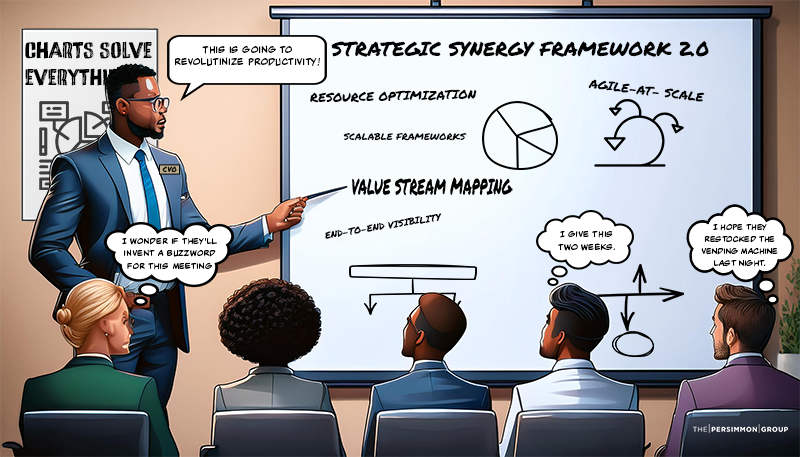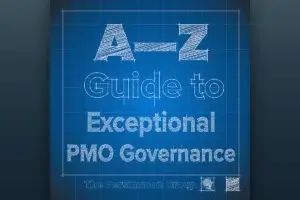You’ve seen it before. The passionate executive, armed with the latest management insights and a genuine desire to boost productivity, rolls out a new initiative. Suddenly, your project management office is buzzing with new metrics, targets, and methodologies. The team nods along, trying to wrap their heads around terms like “resource optimization,” “agile-at-scale,” and “value stream mapping.”
These well-intentioned efforts often lead to unexpected outcomes. They collide with a truth that’s glaringly obvious in hindsight but easily overlooked in the boardroom: Humans are gloriously complex, stubbornly adaptable, and frustratingly irrational creatures. Our behavior has a knack for sidestepping even the most meticulously crafted flowcharts and dashboards. It’s as if we’re allergic to operating within the neat boxes drawn in project plans.
1. The Utilization Myth: Why 100% Engagement Backfires
The Intent: Boost productivity by ensuring every team member is fully engaged.
The Unintended Consequence: Burnout, reduced creativity, and paradoxically, decreased overall output.
The Insight: Humans aren’t CPUs. We need downtime to recharge, innovate, and handle the unexpected. Our brains are wired for periods of focus, followed by periods of diffuse thinking. This ebb and flow isn’t inefficiency—it’s the rhythm of human creativity and problem-solving. When we ignore this rhythm, we don’t just risk burnout; we squander the cognitive processes leading to breakthrough ideas and elegant solutions.
The Opportunity: Instead of aiming for 100% utilization, target 70-80%. Use that “slack” for innovation, problem-solving, and handling the inevitable curveballs. You might find that by doing less, your team accomplishes more.
2. Metrics Overload: When Numbers Distract from Results
The Intent: “What gets measured gets managed.” Improve visibility and control over projects.
The Unintended Consequence: Teams focus on improving metrics rather than actual outcomes, leading to a false sense of progress.
The Insight: Not everything that matters can be measured, and not everything that can be measured matters. Metrics are like spotlights—they illuminate what they’re pointed at, often at the expense of leaving other areas in darkness. The danger lies not in measurement itself, but in our tendency to reshape reality to fit our measurements. We start to mistake the map for the territory, forgetting that our chosen metrics are simplifications of a complex reality, not reality itself.
The Opportunity: Focus on a few key metrics tied directly to value delivery. Supplement these with qualitative assessments. Ask your team: “What’s not captured in our metrics that we should know about?”
3. Planning Pitfalls: The Illusion of Control
The Intent: Create clarity and reduce uncertainty with detailed, long-term plans.
The Unintended Consequence: Rigid plans that crumble at first contact with reality, leading to frustration and wasted effort.
The Insight: The future is inherently uncertain. The more detailed the plan, the more likely it is to be wrong. This isn’t just a truism—it’s a fundamental property of complex systems, which most projects are. Detailed plans create an illusion of control that can be comforting but ultimately misleading. They can also anchor our thinking, making us less likely to adapt when circumstances change. The real skill in project management isn’t creating the perfect plan but navigating the gap between plan and reality.
The Opportunity: Embrace adaptive planning. Set clear goals and milestones, but keep the path flexible. Regular check-ins to adjust the course can be more valuable than a perfect initial plan.
4. The “Heroic Push” Syndrome
The Intent: Rally the troops to meet crucial deadlines and show dedication.
The Unintended Consequence: Burnout, technical debt, and a culture that values overwork over sustainable productivity.
The Insight: Creativity and problem-solving plummet when we’re exhausted. Those late-night coding sessions often create more problems than they solve. The “heroic push” is a remnant of industrial-age thinking, where output was directly proportional to time invested. In knowledge work, this relationship is far more complex. Beyond a certain point, additional hours don’t just yield diminishing returns—they can actually reduce overall productivity. Moreover, glorifying overwork creates a culture of martyrdom that’s toxic in the long run.
The Opportunity: Foster a culture of sustainable pace. Celebrate teams that deliver consistently, not just those that pull all-nighters. When crunch time is truly necessary, balance it with real recovery time.
5. Standardization vs. Flexibility: Finding the Balance
The Intent: Create efficiency through standardized processes across projects and teams.
The Unintended Consequence: Stifled innovation and forced conformity that doesn’t account for unique project needs.
The Insight: Different projects and teams have different needs. Forcing them all into the same mold can be counterproductive. Standardization is a powerful tool, but it’s a means, not an end. The goal should be coherence, not uniformity. When we prioritize standardization over effectiveness, we risk creating processes that look good on paper but fail to deliver in practice. We also undermine the autonomy and creativity that are crucial for solving complex problems.
The Opportunity: Establish guiding principles rather than rigid procedures. Allow teams the flexibility to adapt processes to their specific needs while still maintaining overall alignment.
6. The Silver Bullet Trap: When Methodologies Misfire
The Intent: Rapidly improve outcomes by adopting the latest, greatest methodology.
The Unintended Consequence: Change fatigue, cynicism, and superficial adoption without real transformation.
The Insight: No single methodology is a cure-all. The magic is in thoughtful application, not blind adoption. The allure of the silver bullet is powerful—it promises a simple solution to complex problems. But this simplicity is often illusory. Real improvement comes not from adopting a new methodology wholesale but from understanding the principles behind it and adapting them to your unique context. Moreover, the constant chase for the next big thing can create organizational whiplash, leaving teams skeptical of any change initiative.
The Opportunity: Instead of wholesale adoption of the latest trend, encourage teams to experiment with new methods on a small scale. Foster a culture of continuous learning and adaptation.
Embracing Paradoxes: A Roadmap for Executives
Navigating the world of project management isn’t about finding perfect solutions—it’s about thriving amidst contradictions. Here’s how to cultivate this capacity:
- Cultivate Paradoxical Thinking
Train yourself to hold opposing ideas simultaneously. Ask, “How might both of these conflicting ideas be true?” This opens up new possibilities and solutions. - Embrace Discomfort
Resist the urge to resolve tensions prematurely. Use uncertainty as a catalyst for deeper understanding. - Practice Dynamic Balancing
Think of balance as a dynamic process, making constant micro-adjustments based on current conditions. - Cultivate Contextual Intelligence
Adapt your approach to fit unique situations. What works in one context might fail in another. - Foster Organizational Ambidexterity
Create structures that can handle contradictory processes simultaneously. - Leverage Diverse Perspectives
Surround yourself with people who think differently. The tension between diverse perspectives sparks innovation. - Tolerate Incomplete Information
Accept that you’ll often act with incomplete information in this complex world. Aim for ‘good enough for now, safe enough to try.’
Remember, the goal isn’t to solve paradoxes but to use them as sources of energy and innovation. You can create more robust, adaptive, and successful project management approaches by embracing these tensions.










